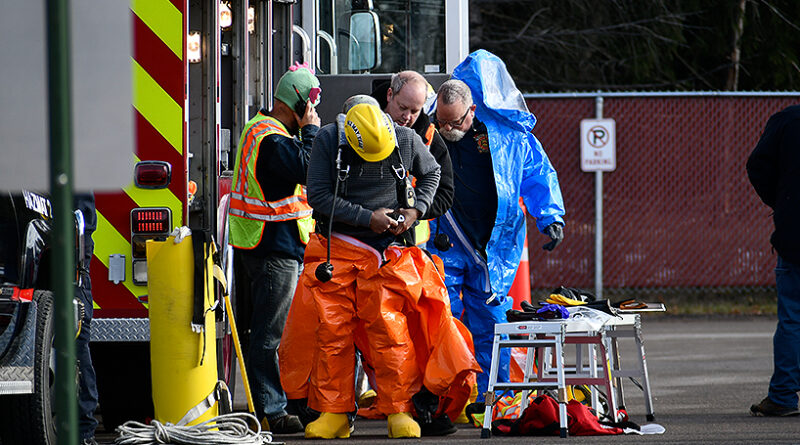Hazmat drill supposes ammonia leak at Monogram
By Brandi Makuski
It was a typical day at Monogram Foods in Plover until employees discovered an unconscious truck driver at the loading docks.
Then, there was that smell. The undeniable stink of ammonia in the air.
It was all a drill, of course, on Dec. 1, as crews from Plover police and fire departments, Portage Co. Emergency Management, and the Waupaca Hazmat team came together for a simulated emergency during daytime functions, with 125 employees in the building at 1434 Post Rd.
Organized by Bonnie Skalecke, deputy director for Portage Co. Emergency Management, the exercise included most of the actual motions undertaken during a real emergency, including some road closures and in-person responses by first responder groups.
The Plover Fire Department houses a hazmat team, but Chief Mark Deaver said it only functions at the “operational” level. For larger chemical spills or leaks, many counties in the region rely on an arm of the Waupaca Fire Department, the “technical” hazmat team.
“If it’s more than a gasoline spill, diesel fuel, for instance, then we call Waupaca, and we use MABAS cards to do that,” Deaver said.
MABAS stands for Mutual Aid Box Alarm System. It’s a predetermined, tiered response system used in large-scale emergencies that helps Portage Co. dispatchers know which combination of fire, EMS, law enforcement, and other agencies to send to an incident.
As part of Saturday’s drill, employees were evacuated, and dispatchers called for a Stevens Point transit bus to the scene to help keep employees warm. Crews also simulated the waiting time for Waupaca to arrive, and technical responders were seen suiting up in the parking lot.
“They go into the scene with a Level A suit, an encapsulated suit with SCBA, everything,” Deaver said. “They’ll be working on a leak or an unknown substance, and they go in with meters.”
Deaver said ammonia is used as a refrigerant in many processing and preservation facilities, and is one of the most common chemicals found commercially in Portage Co.
Skalecke said the purpose of the exercise was to “assess and improve decision-making, coordination, and integration capabilities” for responding to hazardous material incidents. Saturday’s scenario also had simulated causalities to test the readiness of local paramedics.
“It will provide a realistic scenario, testing the readiness and collaborative efforts of participating agencies,” she said.


